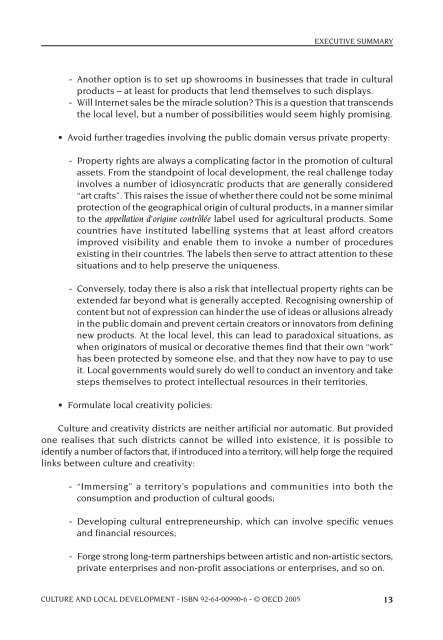OECD Culture and Local Development.pdf - PACA
OECD Culture and Local Development.pdf - PACA
OECD Culture and Local Development.pdf - PACA
You also want an ePaper? Increase the reach of your titles
YUMPU automatically turns print PDFs into web optimized ePapers that Google loves.
EXECUTIVE SUMMARY<br />
- Another option is to set up showrooms in businesses that trade in cultural<br />
products – at least for products that lend themselves to such displays.<br />
- Will Internet sales be the miracle solution? This is a question that transcends<br />
the local level, but a number of possibilities would seem highly promising.<br />
• Avoid further tragedies involving the public domain versus private property:<br />
- Property rights are always a complicating factor in the promotion of cultural<br />
assets. From the st<strong>and</strong>point of local development, the real challenge today<br />
involves a number of idiosyncratic products that are generally considered<br />
“art crafts”. This raises the issue of whether there could not be some minimal<br />
protection of the geographical origin of cultural products, in a manner similar<br />
to the appellation d’origine contrôlée label used for agricultural products. Some<br />
countries have instituted labelling systems that at least afford creators<br />
improved visibility <strong>and</strong> enable them to invoke a number of procedures<br />
existing in their countries. The labels then serve to attract attention to these<br />
situations <strong>and</strong> to help preserve the uniqueness.<br />
- Conversely, today there is also a risk that intellectual property rights can be<br />
extended far beyond what is generally accepted. Recognising ownership of<br />
content but not of expression can hinder the use of ideas or allusions already<br />
in the public domain <strong>and</strong> prevent certain creators or innovators from defining<br />
new products. At the local level, this can lead to paradoxical situations, as<br />
when originators of musical or decorative themes find that their own “work”<br />
has been protected by someone else, <strong>and</strong> that they now have to pay to use<br />
it. <strong>Local</strong> governments would surely do well to conduct an inventory <strong>and</strong> take<br />
steps themselves to protect intellectual resources in their territories.<br />
• Formulate local creativity policies:<br />
<strong>Culture</strong> <strong>and</strong> creativity districts are neither artificial nor automatic. But provided<br />
one realises that such districts cannot be willed into existence, it is possible to<br />
identify a number of factors that, if introduced into a territory, will help forge the required<br />
links between culture <strong>and</strong> creativity:<br />
- “Immersing” a territory’s populations <strong>and</strong> communities into both the<br />
consumption <strong>and</strong> production of cultural goods;<br />
- Developing cultural entrepreneurship, which can involve specific venues<br />
<strong>and</strong> financial resources;<br />
- Forge strong long-term partnerships between artistic <strong>and</strong> non-artistic sectors,<br />
private enterprises <strong>and</strong> non-profit associations or enterprises, <strong>and</strong> so on.<br />
CULTURE AND LOCAL DEVELOPMENT - ISBN 92-64-00990-6 - © <strong>OECD</strong> 2005 13














